Related Research Articles
The Tupi-Guarani mythology is the set of narratives about the gods and spirits of the different Tupi-Guarani peoples, ancient and current. Together with the cosmogonies, anthropogonies and rituals, they form part of the religion of these peoples.
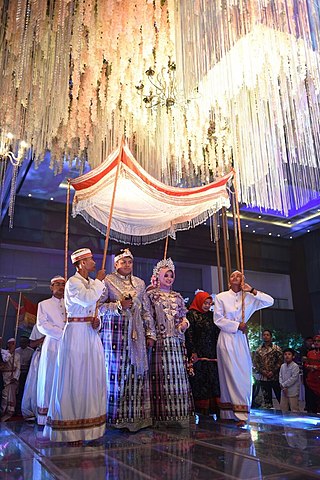
The Bugis people, also known as Buginese, are an ethnicity—the most numerous of the three major linguistic and ethnic groups of South Sulawesi, in the south-western province of Sulawesi, third-largest island of Indonesia. The Bugis in 1605 converted to Islam from Animism. The main religion embraced by the Bugis is Islam, with a small minority adhering to Christianity or a pre-Islamic indigenous belief called Tolotang.

The culture of Indonesia has been shaped by long interaction between original indigenous customs and multiple foreign influences. Indonesia is centrally-located along ancient trading routes between the Far East, South Asia and the Middle East, resulting in many cultural practices being strongly influenced by a multitude of religions, including Buddhism, Christianity, Confucianism, Hinduism, and Islam, all strong in the major trading cities. The result is a complex cultural mixture, often different from the original indigenous cultures.

Tana Toraja is a landlocked regency (kabupaten) of South Sulawesi Province of Indonesia, and home to the Toraja ethnic group. It covers an area of 2,054.30 km2 (793.17 sq mi) and had a population of 221,081 at the 2010 census and 280,794 at the 2020 census; the official estimate as at mid 2021 was 285,179. The local government seat is in the town of Makale, while the traditional center of Toraja culture is in Rantepao. Formerly, the Tana Toraja area covered a larger area, but in 2008 this was divided into two regencies, consisting of Tana Toraja with its capital at Makale and Toraja Utara with its capital at Rantepao.

The Torajans are an ethnic group indigenous to a mountainous region of South Sulawesi, Indonesia. Their population is approximately 1,100,000, of whom 450,000 live in the regency of Tana Toraja. Most of the population is Christian, and others are Muslim or have local animist beliefs known as aluk. The Indonesian government has recognised this animistic belief as Aluk To Dolo.

Batak is a collective term used to identify a number of closely related Austronesian ethnic groups predominantly found in North Sumatra, Indonesia, who speak Batak languages. The term is used to include the Karo, Pakpak, Simalungun, Toba, Angkola, and Mandailing which are related groups with distinct languages and traditional customs (adat).

Hanging coffins are coffins which have been placed on cliffs. They are practiced by various cultures in China, Indonesia, and the Philippines.
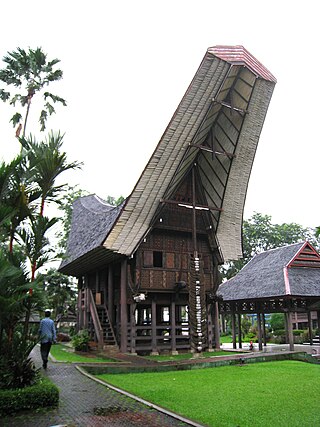
Tongkonan is the traditional ancestral house, or rumah adat of the Torajan people, in South Sulawesi, Indonesia. Tongkonan have a distinguishing boat-shaped and oversized saddleback roof. Like most of Indonesia's Austronesian-based traditional architecture, tongkonan are built on piles. The construction of tongkonan is laborious work and it is usually built with the help of all family members or friends. In the original Toraja society, only nobles had the right to build tongkonan. Commoners live in smaller and less decorated homes called banua.

The Kingdom of Luwu was a polity located in northern part of South Sulawesi. province of Indonesia, on Sulawesi island. It is considered one of the earliest known Bugis kingdom in Sulawesi, founded between 10th and 14th century. However, recent archaeological research has challenged the idea.
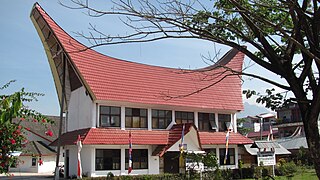
Rantepao is a town and capital of North Toraja Regency, which is known for the cultural center of Toraja ethnic group. National and regional tourism offices have developed the city as the starting point for visiting Tana Toraja, since the area was opened for tourism in the 1970s.
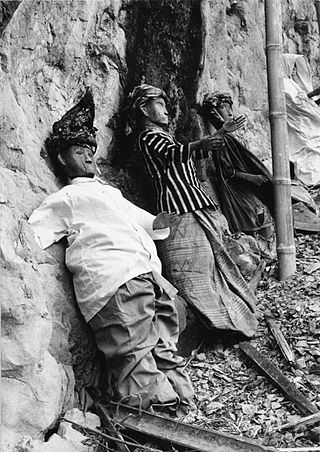
Tau tau are a type of effigy made of wood or bamboo. They are particular to the Toraja ethnic group in South Sulawesi, Indonesia. The word "tau" means "man", and "tau tau" means "men" or "statue".

The mythology of Indonesia is very diverse, the Indonesian people consisting of hundreds of ethnic groups, each with their own myths and legends that explain the origin of their people, the tales of their ancestors and the demons or deities in their belief systems. The tendency to syncretize by overlying older traditions with newer foreign ideas has occurred. For example, the older ancestral mythology might be merged with foreign mythology, such as Hindu, Islam, or Christian biblical mythology.
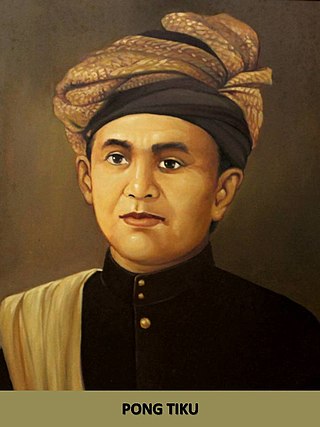
Pong Tiku, known among his Buginese allies as Ne' Baso, was a Torajan leader and guerrilla fighter who operated in southern Sulawesi, part of modern-day Indonesia.
The Teduray are a Filipino ethnic group. They speak the Tiruray language. There were 103,139 of them in 2010. Their name may have come from words tew, meaning people, and duray, referring to a small bamboo hook and a line used for fishing.
The South Sulawesi expeditions of 1905, which included the Third Bone War and the Gowa War, were undertaken by the Royal Netherlands East Indies Army (KNIL) to force the states of south Sulawesi (Celebes) to sign the Korte Verklaring, the standard agreement whereby a native Indonesian ruler agreed to accept Dutch sovereignty. According to certain Dutch historians, the expeditions were an "obligation", because the Dutch had responsibility for law and order. One Indonesian historian has argued that it was actually strategic: that south Sulawesi was the "key" to controlling the so-called Great East. There was also an economic motive: to extend the tax-collecting powers of the government of Sulawesi. The expeditions received the imprimatur of the Governor of Sulawesi, Alexander Kroesen, in a letter dated 11 February 1904.
Selk'nam mythology is the body of myths of the Selk'nam and Haush people of Tierra del Fuego.

The indigenous religious beliefs of the Tagalog people were well documented by Spanish missionaries, mostly in the form of epistolary accounts (relaciones) and entries in various dictionaries compiled by missionary friars.

The Mamasa is a ethnic group residing in Mamasa Regency, West Sulawesi. The Mamasa community is known in districts in Mamasa Regency. The Mamasa people are part of the Toraja sub-people. Mamasa language is similar to Toraja language. The Mamasa people are often referred to as the Toraja Mamasa people.

The Torajan Muslims is a term for Torajan people who follow the Islam religion. Islam itself is a minority religion adhered to by Torajans. In general, the Torajan people adhere to Christianity; majority Protestant. In addition, small Torajan Muslim communities of muallaf are also found in Bontang City, East Kalimantan; a place where many Torajans migrants are found.

Tolotang is the original religion of Bugis which is adhered to by the majority in several areas within the province of South Sulawesi, Indonesia, especially in Sidenreng Rappang Regency or commonly known as Sidrap Regency.
References
- ↑ Sejarah RI: Aluk Todolo Kepercayaan Suku Toraja Archived 2019-03-27 at the Wayback Machine . Accessed March 20, 2019.
- ↑ Saransi, Ahmad (2003). Tradisi Masyarakat di Sulawesi Selatan. Makassar: Lamacca Press. p. 25.